By Brooke Fisher
“No one has ever put light rail on a floating bridge, so there is no precedent. You can’t just pull a design off the shelf and say ‘Let’s do this the same as before.’"
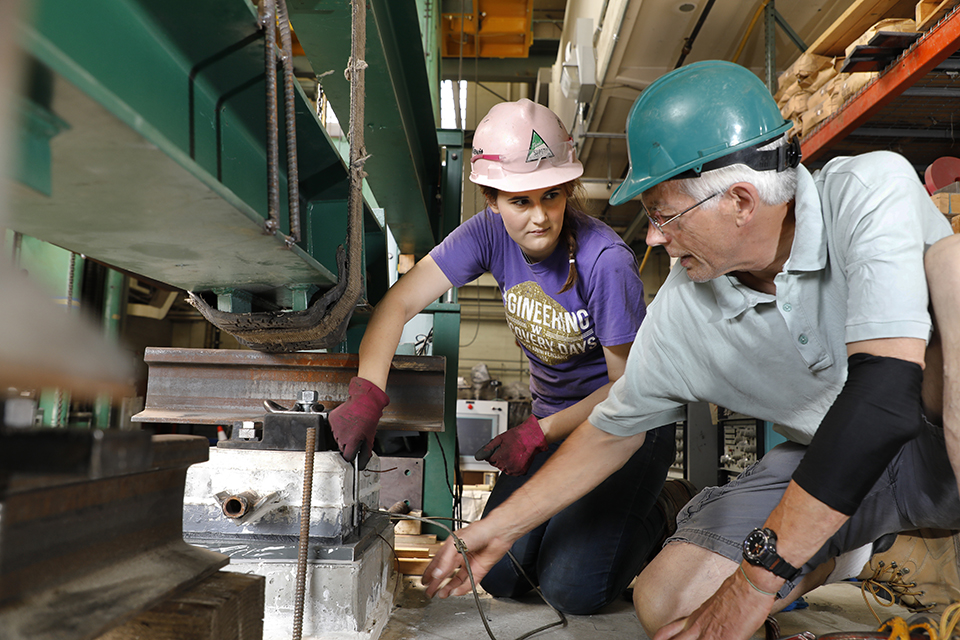 CEE graduate research assistant Kristina Tsvetanova and professor John Stanton discuss an appropriate location for a potentiometer that will record data during testing of the latest prototype designed to secure rails to the I-90 bridge deck without the use of bolts. Photo credit: Brian DalBalcon.
CEE graduate research assistant Kristina Tsvetanova and professor John Stanton discuss an appropriate location for a potentiometer that will record data during testing of the latest prototype designed to secure rails to the I-90 bridge deck without the use of bolts. Photo credit: Brian DalBalcon.
Most engineers dream of being able to work on great engineering challenges. And some, including a handful of UW CEE researchers, actually work on them.
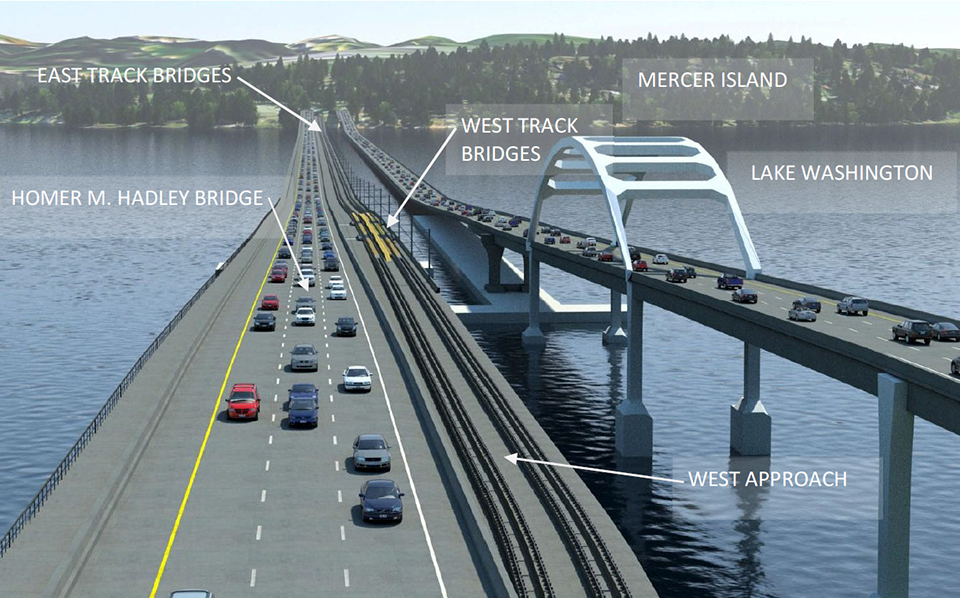 The location of light rail on the I-90 bridge. Credit: Sound Transit.
The location of light rail on the I-90 bridge. Credit: Sound Transit.
Light rail will cross a floating bridge for the first time in the world when construction is completed on Sound Transit’s East Link Extension Project in 2023. The engineering feat is possible thanks to the work of UW CEE researchers, led by professor John Stanton, who have collaborated with Sound Transit officials and Parsons Brinckerhoff consultants for the past five years. The UW CEE researchers have been primarily involved in testing various prototypes, which have never before been implemented.
“No one has ever put light rail on a floating bridge, so there is no precedent,” Stanton said. “You can’t just pull a design off the shelf and say ‘Let’s do this the same as before.’ At every turn you have to be ready for something coming at you from left field.”
Construction kicked off on the project in June 2017. The project entails replacing two lanes down the middle of the Homer M. Hadley Memorial Bridge, commonly known as I-90, with dual-track light rail.
UW CEE researchers are currently testing a prototype to resolve a final engineering challenge. As their work starts to wind down, their fingerprints can be seen on various aspects of the project, which will enable an engineering challenge to become a reality.
East Link I-90 Track Bridge from Sound Transit Video on Vimeo.
The first challenge: Constantly changing lake levels
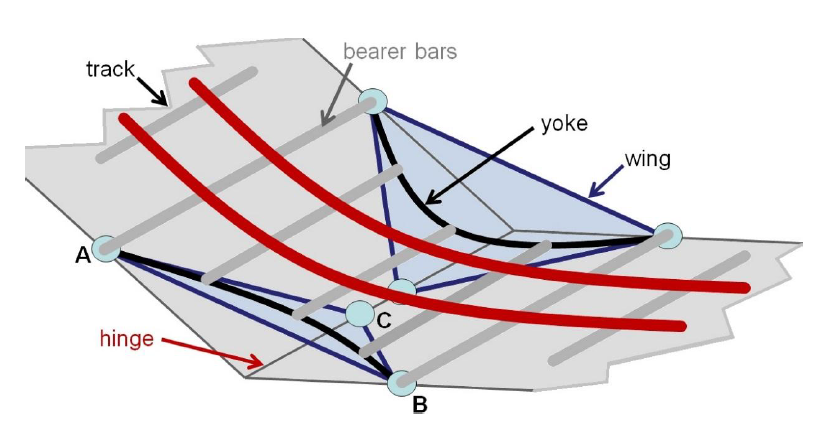 The CESuRa system is designed to enable light rail to smoothly cross areas between fixed and floating portions of the bridge. Credit: Sound Transit.
The CESuRa system is designed to enable light rail to smoothly cross areas between fixed and floating portions of the bridge. Credit: Sound Transit.
The history of the light rail addition dates back to 1976, when a pact was signed to add high-capacity transit to the I-90 bridge. It wasn’t until 2010, however, that Sound Transit officials were ready to start working on the feasibility of the project and hired consultants with Parsons Brinckerhoff.
The primary challenge was figuring out how to address the constantly changing levels of the lake and other movements that affect the bridge. Depending on the season, the water level of Lake Washington fluctuates up to three feet from winter to summer. The floating bridge is also vulnerable to other forces, such as wind, waves and vehicle weight. This constant movement becomes problematic where the floating sections meet the fixed sections of the bridge, which are joined by hinge-like transition spans. When the water is low, the steepness of the transition span increases. While this isn’t a problem for vehicles, it is an issue for inflexible light rail tracks.
“This was the first problem they came up against, which is where we came in,” Stanton said. “The rails would need to bend like a hinge at the transition spans. But rails, made of stiff, strong steel, don’t bend like that. So you have a problem.”
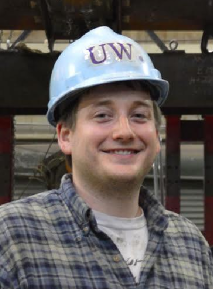 UW CEE alumnus Travis Thonstad (Ph.D. ’16). Photo credit: Joanna Kresge.
UW CEE alumnus Travis Thonstad (Ph.D. ’16). Photo credit: Joanna Kresge.
To enable light rail to smoothly cross the transition spans, an engineer from England, Andy Foan, developed a novel system called the Curved Element Supported Rail (CESuRa) track bridge system. The system responds to changes in the lake level and movement from all directions, including vertical, lateral and roll forces.
This is achieved with curved track supports in two independent planes, which automatically adjust in response to bridge movements, ensuring the track remains smooth across the transition spans. The system borrows a critical concept from earthquake engineering: don’t fight the forces. The curved track supports sit atop bearings that move several inches in all directions in response to various bridge movement, keeping the rail steady above.
“It all comes down to this passively adjusting system. The way the system works is quite clever in that it supports the railroad ties on a curve,” said UW CEE alumnus Travis Thonstad (Ph.D. ‘16), who worked on the project while earning his master’s degree.
Prototype testing of the CESuRa system started in 2012, which Thonstad oversaw in the Structural Research Laboratory. A quarter of the system was tested at full-scale on a custom designed steel rig that simulates train motion with vertical weight and other forces, such as wind and waves, through horizontal motion.
The testing uncovered a few initial problems, such as just how precisely the system needed to be fabricated and assembled in order for it to properly work.
“It works like a Swiss watch, so we had to work it out a piece at a time,” Thonstad said. “But the challenges ended up paying off in the end, in terms of making sure the product was better.”
Following the prototype testing, full-scale testing took place at the Transportation Technology Center in Pueblo, Colorado, in 2013. Thonstad worked alongside consultants with Parsons Brinckerhoff during the six-month testing process, which entailed testing two CESuRa systems at high speeds with various water levels on a customized 5,000 foot-long track. The testing confirmed that the system not only worked, but met safety standards and could operate at a speed of 55 mph, which was faster than engineers initially thought possible.
The second challenge: Attaching rails without bolts
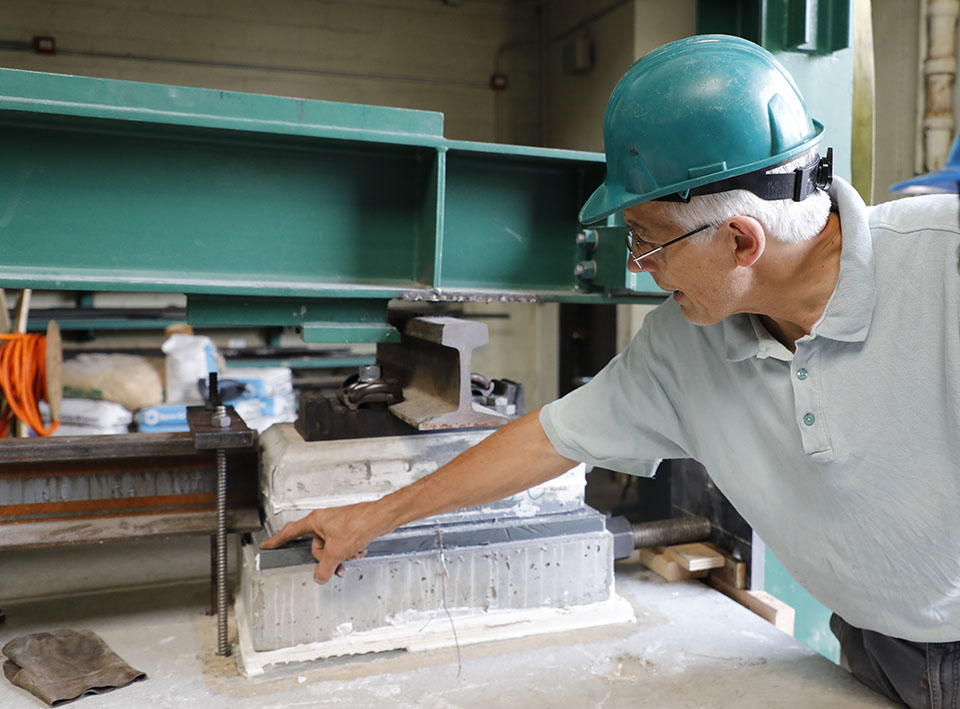 Professor John Stanton inspects hold-down rods that restrain vertical motion of the base block during prototype testing. The latest prototype, shown here, consists of adhesives nestled between concrete blocks. Photo credit: Brian DalBalcon.
Professor John Stanton inspects hold-down rods that restrain vertical motion of the base block during prototype testing. The latest prototype, shown here, consists of adhesives nestled between concrete blocks. Photo credit: Brian DalBalcon.
A second technical challenge was looming, this time of a different nature. As part of Sound Transit’s agreement to add light rail to the I-90 floating bridge, which is owned by the Washington State Department of Transportation and regulated by the Federal Highway Administration, it was stipulated that holes could not be drilled into the existing bridge. This meant that connecting the light rail track to the bridge via traditional methods, such as bolts or dowels, was out of the question.
“Because it is a floating bridge, even a single hole in the bridge deck is not allowed,” said CEE graduate research assistant Kristina Tsvetanova, who is testing the attachment solution. “Engineers had to come up with a completely new system.”
Sound Transit engineers dreamed up many schemes and settled on layering adhesives between the bridge deck and rails. While this may sound like a simple solution, it wasn’t without challenges.
In addition to securing the rails to the bridge deck, the adhesives must also perform other functions. Without soil underneath the rails, the adhesives must adequately absorb track vibrations to ensure a smooth ride. The adhesives also must be flexible enough to not cause the concrete to crack due to shrinkage after the curing process.
The first adhesive prototype was tested in 2014 by UW CEE alumnus Matthew Sisley (MSCE ’15). After many rounds of testing, Sisley found that the adhesives were not flexible enough to absorb track vibrations.
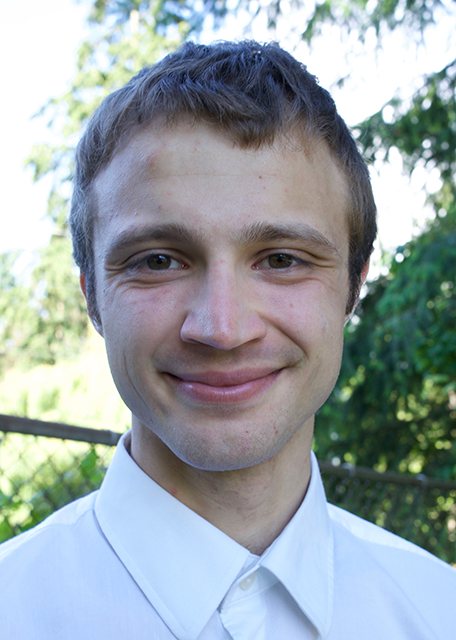 UW CEE alumnus Matthew Sisley (MSCE ’15).
UW CEE alumnus Matthew Sisley (MSCE ’15).
“We provided reports to Sound Transit that indicated they needed to move in another direction,” Sisley said. “The consultants basically took our test results and used that to inform the next iteration of the design.”
Now, three years later, a final prototype is being tested to confirm the design changes from previous test results. The attachment solution consists of a layer of epoxy grout above which a rubbery material, called Corkelast, rests. Compared to the first prototype, it features a different concrete block design and a new type of metal fastener, or “rail clip.” Tsvetanova is leading the team conducting the tests, which will evaluate whether the concrete blocks crack, if the layers separate, and if vibrations are adequately absorbed.
This fall, the researchers will conduct additional tests on blocks that have been heated and cooled to simulate seasonal changes, to determine the durability of the attachment solution.
As the researchers wrap up the final prototype testing, they can look forward to seeing their hard work pay off when light rail crosses a floating bridge for the very first time.
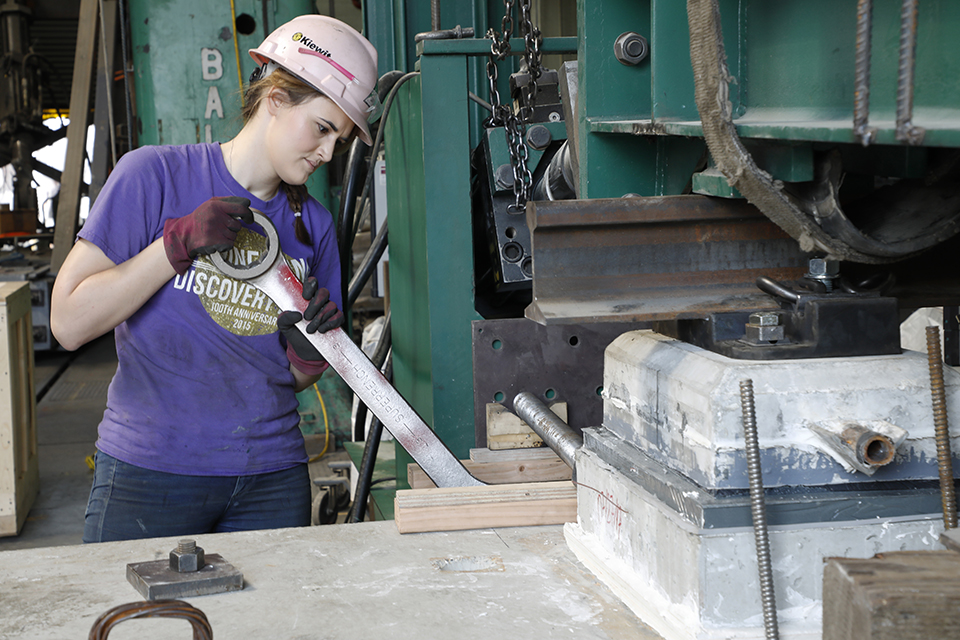 CEE graduate research assistant Kristina Tsvetanova tightens a slab end restraint on a custom-designed steel rig that simulates train motion during prototype testing. Photo credit: Brian DalBalcon.
CEE graduate research assistant Kristina Tsvetanova tightens a slab end restraint on a custom-designed steel rig that simulates train motion during prototype testing. Photo credit: Brian DalBalcon.
Originally published August 28, 2017